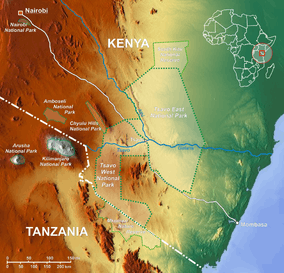Tsavo Trust
 | |
|
Location of Tsavo National Parks | |
| Founder |
Nzioki Wa Makau (chairman of the board) Tanya Saunders (CEO) Ian Saunders (COO), Richard Moller (CCO) |
|---|---|
| Location |
|
| Coordinates | 02°41′24″S 38°41′24″E / 2.69000°S 38.69000°E |
Area served | Tsavo ecosystem (16,000 square miles (41,000 km2)) |
| Services | Conservation |
Key people |
Tanya Saunders (CEO) Ian Saunders (COO) Richard Moller (Chief Conservation Officer) |
| Mission | To support of wildlife, habitat, and communities in the Tsavo ecosystem |
| Website |
tsavotrust |
The Tsavo Trust is a non-profit wildlife conservation organisation, which covers Tsavo East National Park, Tsavo West National Park, and Chyulu Hills National Park in Kenya. The trust was founded by Nzioki wa Makau who is chairman of the board, along with Tanya Saunders who is chief executive officer, Ian Saunders chief operations officer, and Richard Moller who is chief conservation officer and pilot. The started aim of the trust is the protection of wildlife, especially African elephants, and the reduction of the ivory trade.[1][2] In June 2014, the Tsavo Trust came into the international spotlight when it announced the death of Kenya's iconic and most well-known elephant, Satao, killed by an ivory poacher with a poisoned arrow.[3][4][5][6]
The Tsavo ecosystem consists of 16,000 square miles (41,000 km2) or arid and semi arid land in southern Kenya. The national parks within this region are managed by Kenya Wildlife Service. Around the parks, but within the Tsavo ecosystem, are a number of small towns, villages, ranches, and farms. Contained in this system is the largest population of African elephants in Kenya, numbering 12,000 as of 2011.[1][2][7][8]
There are a number of critical issues in the Tsavo ecosystem which include: a high rate of poverty among the people in the region, poor access to education and healthcare, degradation of habitat, ethnic conflict over resources, loss of wildlife, and lack of financial and technical resources to deal with these issues. In this context, the stated mission of the Tsavo Trust is to (1) facilitate the development of community-based wildlife conservancies that mutually benefit both the wildlife and people of this region; (2) enhance wildlife conservation in support of the Kenya Wildlife Service and the community conservancies that they help to develop and thereby create more secure park boundaries to reduce poaching; (3) develop multimedia educational tools to increase public awareness of wildlife conservation issues; and (4) facilitate wildlife animal welfare.[1][2][7][8]
References
- 1 2 3 Muumbi, Susan (29 November 2013). "Keeping the African elephant alive". The EastAfrican. Archived from the original on 15 June 2014. Retrieved 15 June 2014.
- 1 2 3 Plesant, Maranda (31 December 2013). "Ian Saunders, COO Tsavo Trust". Origin. Archived from the original on 15 June 2014. Retrieved 15 June 2014.
- ↑ Peralta, Eyder (14 June 2014). "One of Kenya's Legendary 'Tuskers' Is Killed By Poachers". NPR. Archived from the original on 15 June 2014. Retrieved 15 June 2014.
- ↑ Kahumbu, Paula (2014). "Kenya's biggest elephant killed by poachers". The Guardian. Archived from the original on 15 June 2014. Retrieved 15 June 2014.
- ↑ Flood, Zoe (14 June 2014). "Poachers kill one of the world's largest elephants in Kenya". The Daily Telegraph. Archived from the original on 15 June 2014. Retrieved 15 June 2014.
- ↑ Staff (15 June 2014). "Kenya's iconic elephant Satao is dead in Tsavo". Kenya Television Network. Archived from the original on 15 June 2014. Retrieved 15 June 2014.
- 1 2 "Stabilization through Conservation" (PDF). http://iccfoundation.us. International Conservation Caucus Foundation. Archived from the original on 15 June 2014. Retrieved 15 June 2014. External link in
|website=(help) - 1 2 Taveta, Taita (10 February 2013). "Determining Elephant Populations in Tsavo". International Fund for Animal Welfare. Archived from the original on 15 June 2014. Retrieved 15 June 2014.
External links
- Tsavo Trust Official Site
- Tsavo East National Park
- Tsavo West National Park
- Amboseli National Park
- Chyulu Hills National Park
